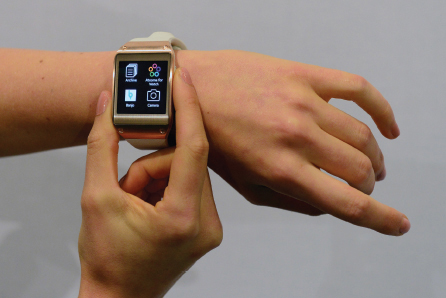Mobile Devices Propel Convergence
Mobile telephones have been around for decades (like the giant “brick” mobile phones of the 1970s and 1980s), but the mobile phones of the twenty-first century are substantially different creatures—smartphones that go beyond voice calls. They can be used for texting, listening to music, watching movies, connecting to the Internet, playing games, and using hundreds of thousands of applications, or “apps” as they quickly became known.

The Blackberry was the first popular Internet-capable smartphone in the United States, introduced in 2002. Users’ ability to check their e-mail messages at any time created addictive e-mail behavior and earned the phones their “Crackberry” nickname. Convergence on mobile phones took another big leap in 2007 with Apple’s introduction of the iPhone, which combined qualities of its iPod digital music player and telephone and Internet service, all accessed through a sleek touchscreen. The next year, Apple opened its App Store, featuring free and low-cost software applications for the iPhone (and the iPod Touch and, later, the iPad) created by third-party developers, vastly increasing the utility of the iPhone. By 2013 there were about one million apps available to do thousands of things on Apple devices—from playing interactive games to finding locations with a GPS or using the iPhone like a carpenter’s level.
In 2008, the first smartphone to run on Google’s competing Android platform was released. By 2013, Android phones (sold by companies such as Samsung, HTC, LG, and Motorola, and supported by the Google Play app market and the Amazon Appstore) held more than 51 percent of the smartphone market share in the United States, while Apple’s iPhone had a 42 percent share; Blackberry and Microsoft smartphones constituted the remainder of the market.17 The precipitous drop of the Blackberry’s market standing in just ten years (the company was late to add touchscreens and apps to its phones) illustrates the tumultuous competition in mobile devices. It also illustrates how apps and the ability to consume all types of media content on the go have surpassed voice call quality to become the most important feature to consumers purchasing a phone today.
In 2010, Apple introduced the iPad, a tablet computer that functions like a larger iPod Touch, making it more suitable for reading magazines, newspapers, and books; watching video; and using visual applications. The tablets became Apple’s fastest-growing product line, selling at a rate of twenty-five million a year. Apple added cameras, faster graphics, and a thinner design to subsequent generations of the iPad, as other companies like Samsung rolled out competing tablets. The biggest rival to the iPad is the Kindle Fire, a low-cost tablet developed by Amazon. Amazon found success with its e-readers, but as more users expect their digital devices to perform multiple functions, Amazon recognized that it would need to add a touchscreen, apps, and access to other content like music and movies to their devices in order to stay relevant in users’ increasingly interconnected and converged lives.